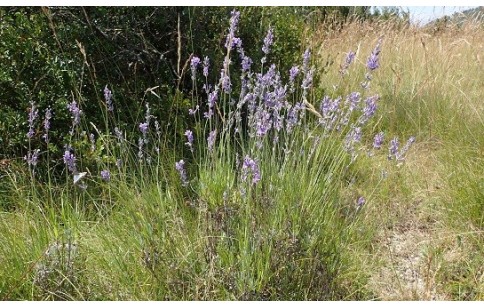- Code : #5455 S 1 g
- Formula : C₁₀H₁₆O
- CAS : 76-22-2
Lavandula angustifolia
Lavandula angustifolia, “Lavender” or “True lavender” in English and “Lavande officinale” in French, belongs to the Lamiaceae botanical family. Native to the Mediterranean region, it is a shrub of 30 to 60 cm on average.
The fragrant flower is used as a culinary herb ; also as a prevention against clothing moths. Its essential oil is used for making perfumes, soaps and cosmetics.
The drug is applied as a mild sedative, often included in calming teas, and also used as a cholagogue. In folk medicine, it is employed as a spasmolytic, carminative, somachic and diuretic. Lavender baths are prepared for the treatment of wounds and a mild stimulant for the skin.
The main components of its essential oil (1 to 3%) are monoterpenes, mainly linalyl acetate, also linalool, ß-ocimene, cineole and camphor; the sesquiterpene caryophyllene oxide; tannins, flavonoids (luteolin and acacetin) and phytosterols.

- Code : #5493 100 mg
- Formula : C₁₅H₂₄O
- CAS : 1139-30-6
- Code : #5009 S 100 mg
- Formula : C₁₀H₁₈O
- CAS : 470-82-6
- Code : #5406 S 100 mg
- Formula : C₁₂H₂₀O₂
- CAS : 25905-14-0
- Code : #5082 S 100 mg
- Formula : C₁₀H₁₆
- CAS : 5989-27-5
- Code : #5041 S 100 mg
- Formula : C₁₀H₁₈O
- CAS : 78-70-6
- Code : #5004 S 100 mg
- Formula : C₁₂H₂₀O₂
- CAS : 115-95-7
- Code : #1126 S 20 mg
- Formula : C₂₁H₂₀O₁₁
- CAS : 5373-11-5
- Code : #5261 1 g
- Formula : C₁₀H₁₈O
- CAS : 562-74-3
- Code : #5077 S 100 mg
- Formula : C₁₀H₁₈O
- CAS : 98-55-5











